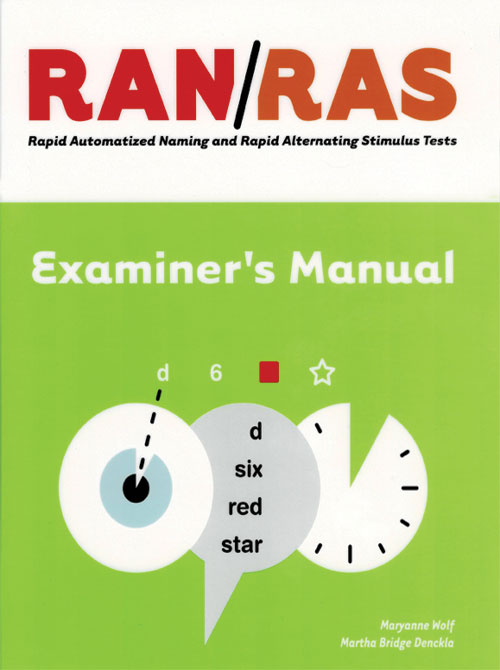by Maryanne Wolf, EdD, Martha Bridge Denckla, MD
Purpose: Assess ability to recognise visual symbols in ages
Purpose: Assess ability to recognise visual symbols in ages
Age: 5 through to 18.11 years
Admin: Individual
Time: 5-10 minutes to complete
Admin: Individual
Time: 5-10 minutes to complete
Qualification Level: B
Considered the "gold standard" of naming tests, the RAN/RAS reflects 30 years of clinical evidence and research examining the relationship between reading and processing speed.The RAN/RAS tests provide an important component to any predictive battery or diagnostic assessment of oral and written language. The tests consist of rapid automatised naming tests (i.e., Letters, Numbers, Objects, Colours) and two rapid alternating stimulus tests (i.e., 2-Set Letters and Numbers; 3-Set Letters, Numbers, and Colours). The Letters, Numbers, Colours, and Objects tests are made up of five high-frequency stimuli that are repeated randomly 10 times in an array of five rows for a total of fifty stimulus items. The 2-Set Letters and Numbers test and the 3-Set Letters, Numbers, and Colours test are made up of 10 and 15, respectively, high-frequency stimuli that are randomly repeated in an array of five rows for a total of 50 stimulus items. The examinee is asked to name each stimulus item as quickly as possible without making any mistakes on all tests. Scores are based on the amount of time that is required to name all stimuli on each test. The RAN/RAS materials include the Examiner's Manual, Examiner Record Forms, and a set of 5 Card Packs.
Norming of the tests was performed with 1,461 individuals, ranging in age from 5.0 years to 18.11 years. Characteristics of the normative sample were well-matched to that of the school-aged population for, age, gender, race/ethnicity, parental education obtained, and exceptionality status. Resultant test scores are reported in terms of standard scores, percentile ranks, and age/grade equivalents.
Reliability and Validity
Test-retest reliability coefficients ranged from .84 to .92 for all age groups, with a test-retest interval of approximately 2 weeks. Interrater reliabilities indicate a high level of agreement between raters, with coefficients ranging from .98 to .99. Good evidence of validity for the RAN/RAS is demonstrated via content-description validity, criterion-prediction validity, and construct-identification validity. Additional validation studies concluded that the RAN/RAS tests are valid measures of the ability to perceive a visual symbol and name it accurately and rapidly and that this ability differentiates many children who have reading disabilities from children who read with average abilities.
Features of the RAN/RAS
* Identifies students who may be at risk for reading failure.
* Is quick to administer and is easy to score.
* Converts raw scores to standard scores, percentiles, and age and grade equivalents.
* Is appropriate for use with kindergarten students through to secondary school students.




